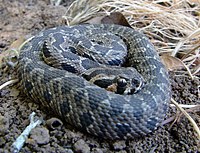Vipera palaestinae
| Vipera palaestinae | ||||||||||||||||||||
|---|---|---|---|---|---|---|---|---|---|---|---|---|---|---|---|---|---|---|---|---|
 | ||||||||||||||||||||
| Conservation status | ||||||||||||||||||||
| Scientific classification | ||||||||||||||||||||
| ||||||||||||||||||||
| Binomial name | ||||||||||||||||||||
| Vipera palaestinae Werner, 1938 | ||||||||||||||||||||
| Synonyms | ||||||||||||||||||||
|
Common names: Palestine viper.[2]
Vipera palaestinae is a venomous viper species found in Syria, Jordan, Israel and Lebanon.[1] Considered a leading cause of snakebite within its range.[3] No subspecies are currently recognized.[4]
Description
Grows to an average length of 70-90 cm, with a maximum of 130 cm.[2]
Geographic range
Syria, Jordan, Israel and Lebanon.[1] Mallow et al. (2003) describe the range as relatively restricted, with the distribution being concentrated in the Mediterranean coastal plains to the inland hills of Lebanon and Israel, along with the adjoining regions of Syria and Jordan.[2] The type locality given is "Haifa, Palästina" [Israel].[1]
Conservation status
This species is classified as Least Concern (LC) according to the IUCN Red List of Threatened Species (v3.1, 2001).[5] It was given this status due to its relatively wide distribution, the fact that it is found in a wide range of habitats, its presumed large population, and because it is unlikely to be declining fast enough to qualify for listing in a more threatened category. Year assessed: 2005. [6]
Taxonomy
The classification of this species has resulted in much taxonomic controversy. Before Werner (1938), these snakes were incorporated into V. xanthina, and subsequently synonymized with V. lebetina by Boulenger (1896). Mertens (1952) moved it back to V xanthina as a subspecies, and more recently a number of authorities, including Obst (1983) and Mallow et al. (2003) have included it as part of the genus Daboia.[2] The result is that many studies related to this medically significant species have been published under different scientific names.[2]
See also
- Vipera.
- List of viperine species and subspecies.
- True vipers - Common names.
- True vipers - Synonymy.
- Snakebite.
Cited references
- ↑ 1.0 1.1 1.2 1.3 McDiarmid RW, Campbell JA, Touré T. 1999. Snake Species of the World: A Taxonomic and Geographic Reference, vol. 1. Herpetologists' League. 511 pp. ISBN 1-893777-00-6 (series). ISBN 1-893777-01-4 (volume).
- ↑ 2.0 2.1 2.2 2.3 2.4 Mallow D, Ludwig D, Nilson G. 2003. True Vipers: Natural History and Toxinology of Old World Vipers. Krieger Publishing Company, Malabar, Florida. 359 pp. ISBN 0-89464-877-2.
- ↑ U.S. Navy. 1991. Poisonous Snakes of the World. US Govt. New York: Dover Publications Inc. 203 pp. ISBN 0-486-26629-X.
- ↑ Vipera palaestinae (TSN 634998). Integrated Taxonomic Information System. Accessed on 18 August 2006.
- ↑ Daboia palaestinae at IUCN Red List. Accessed 6 October 2006.
- ↑ 2001 Categories & Criteria (version 3.1)IUCN Red List. Accessed 6 October 2006.
External links
- Species Vipera palaestinae at the Species2000 Database
